August/September 2019
Clouds & Linings
Well, Okay, but if we scrap Plan A, what do we do then?
We last wrote you from far southern Malawi. Remember us getting stuck in the mud? It was one of the defining moments of that message. Following that adventure, we returned to our campsite and stayed in the area to lick our wounds for a day or so before heading on out. After shaking off some of the mud, we left the lovely tea plantations in the shadow of Mt Mulanje and embarked on a month-long journey seemingly made up of fits and starts and course changes, but also of new and interesting experiences and visits with friends both old and new.
Over the course of the month, we talked a lot about visiting Zimbabwe. We had been wanting to do this as Zimbabwe reportedly has some of the friendliest people in Africa, some beautiful countryside, and — very high on our list — an area called the Eastern Highlands, which are supposed to be quite special. But there was lots of talk about corruption, money problems, fuel availability, and other difficulties. Not surprisingly the people have been getting more and more restless over these problems, and there were reports of troubles with police quelling demonstrations, including some that were very current. Ultimately, after discussing it for many days, we reluctantly decided to give Zimbabwe a pass.
As these chats went on, we continued enjoying ourselves in the last part of Malawi we were planning to visit, Blantyre. This city is not the capital of Malawi, but still a huge, modern city. We’ve been told it’s the financial center of the country. Lots of foreign corporations, cars and general chaos. We did some badly needed city-shopping there, although already we were missing the constant array of beautiful fresh produce that had been available along the roadways in the southern part of the country.
We settled into the parking area of a lodge in the city for the night, and experienced Malawi kindness yet another time. Our experience with the mud was now evident to anyone glancing at the Tiger, so after a little chat to welcome us to the lodge, the manager asked if it would be all right if his guys washed our truck — for free. Thank you we said, once again.
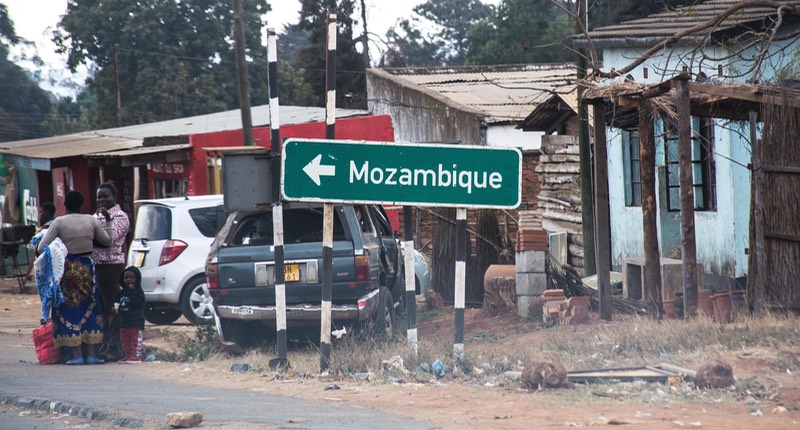
Having changed our route, we knew we would be going back into Zambia, where we’d be able to see parts of that country we’d missed on our earlier visit; so we turned north, back to Lilongwe, and then headed west to enter Zambia at Chipata.
Returning to Lilongwe was easy, up through the countryside and over some mountains (highest pass was a very pleasant 1631 meters), all this time dancing right along the edge of the Mozambique border. We entered a quite fertile and productive area with plenty of produce along the roadside — along with fried mice available for lunch if we desired. We did more shopping in Lilongwe, revisiting some stores we’d enjoyed and having a nice lunch — no, not fried mice — at our favorite restaurant in town, Coco’s.
At the border, we were sad that we were now about to leave Malawi, probably forever. As is often the case, we arrived with extra kwacha to spend, so we topped up with fuel and worked on filling our produce bag. We sure do love the fresh produce you can find along the road here — much better than anything in the stores, sadly.
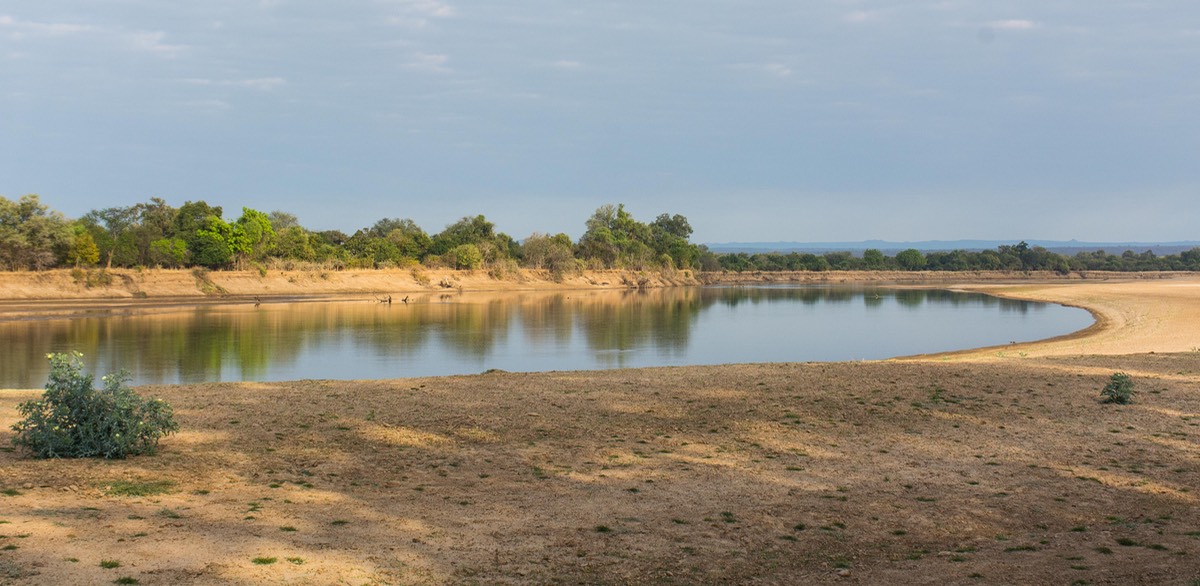
Chipata is a busy border crossing, with tons of trucks making the run from one faraway place to another. Sure wish we owned a big trucking outfit here in Africa! The problem, naturally, is that the trucks get hung up going between countries, and often have to sit for days waiting for clearance. It’s a tough, crummy life for them. But we didn’t have to wait; cleared customs and immigration, paid some road tax, waved our COMESA insurance guarantee in front of several faces, and beat feet. And here we were, back in Zambia.
This was not a bad thing; it was actually pretty super. We were heading directly towards two of the country’s biggest attractions, both of which we hadn’t seen during our visit in June: South Luangwa NP, and Lower Zambezi NP. Each of these parks is situated along the banks of a beautiful river, with elephants and crocodiles and hippos wandering around at will — much to enjoy. In Zambia, the costs to enter the national parks and see the big game animals are pretty high, whether you drive in yourself or take organized game drives, so decisions on that were unsettled. But we had a beginning plan for the South Luangwa area as a whole.
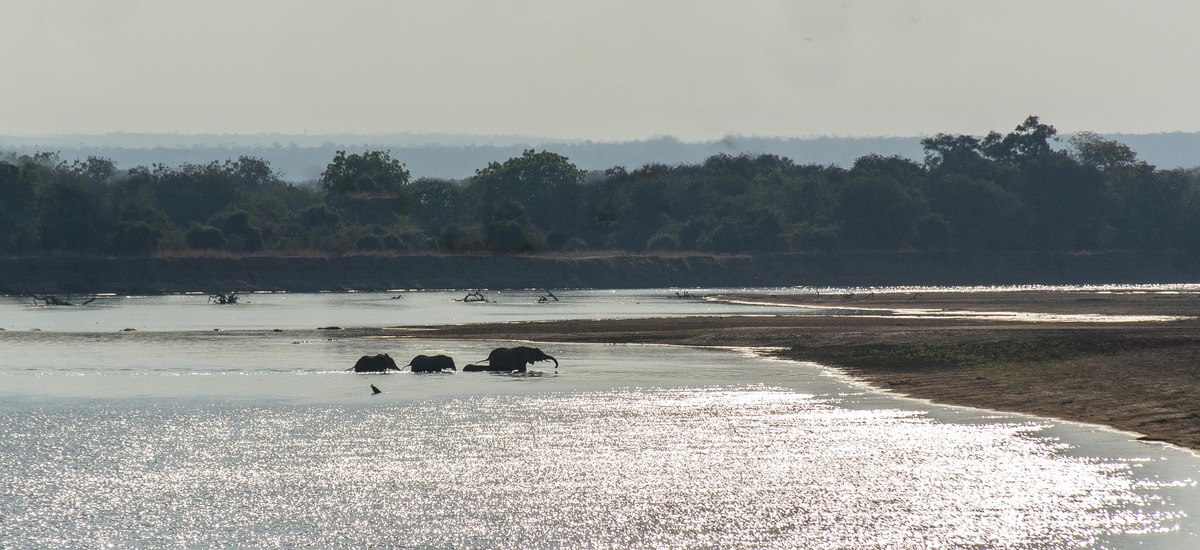
After a night in Chipata, we headed straight for a private camp near Mfuwe, right on the outer edge of South Luangwa NP and this turned out to be a great choice.
The camp was right on a bend in the river, with great views in all directions, amazing sunsets, and was incredibly peaceful. We wouldn’t even have to drive into the park in order to spot the critters — they were right outside our door, including a large family of baboons that were super entertainment. Our fellow campers, who went into the park on drives, reported back they had leopard sightings, but that otherwise we didn’t miss much; we didn’t feel left out. A couple we’d met earlier, back in Malawi, came through one afternoon and shared some more info on our spot. They were camped in another of the four or five camps in the area and had been driving around checking the views and facilities of them all. They immediately declared this one the best.
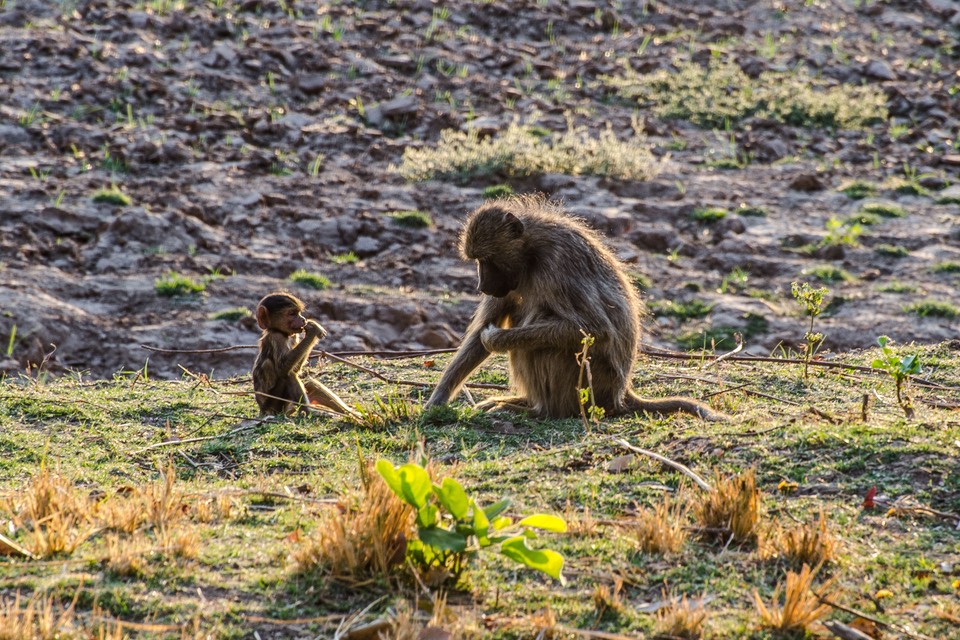
We saw our first (and only) herd of puku, a rather undramatic antelope that can be hard to find. Our herd lived down around the bend, and came along each afternoon to have a sunset snack.
However, they were outclassed by this mostly happy but sometimes quarreling family of baboons, living under an edge of the bank quite close to us. They spent their mornings and evenings out foraging and fussing at each other, arguing over every little thing they could find to disagree about. We watched three of them really get into it at one point, churning up the dust and yelling and screeching at each other. The head honcho finally walked off in disgust, and the dust, both literal and proverbial, finally settled.
Another morning we were awakened by a large group of these guys landing on the truck and jumping around — sliding off the front hood, running back and forth among the solar panels on the roof, generally working on their circus act — “Here they come folks: the Bouncing Baboons!!” We’d had this happen before, by the small Vervet monkeys we see frequently, but the baboons are big guys. Heavy, man!
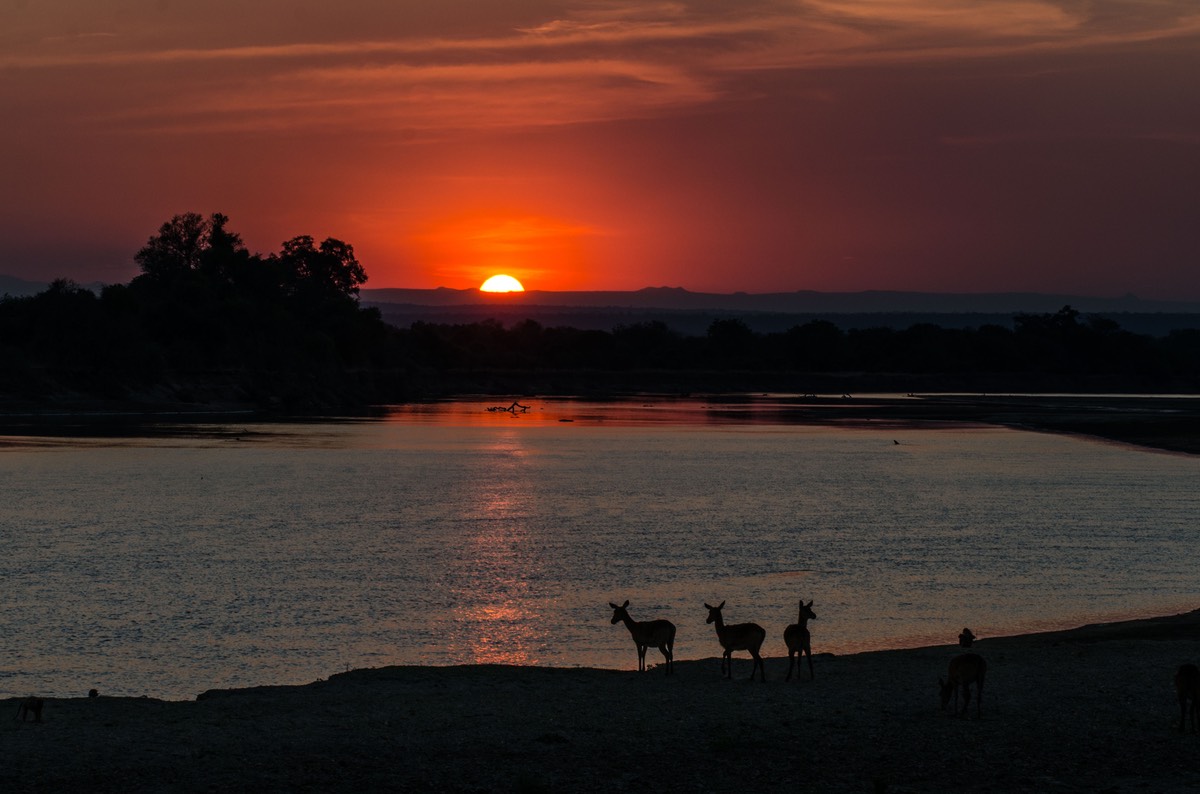
The sunsets were the best thing of all. The sun went down right across the river from us and started out dark orange, then turned to red and then pink as the light faded. We enjoyed elephants and hippos crossing in the approaching darkness, boats carrying men and goods along, and crocodiles floating imperturbably along on the slowly moving river. Really delightful.
The company was good, too. Win and Petra were there waiting for us, which was great fun. There also were Peace Corps folks there (20-somethings mostly hailing from California) for several days with a group of school kids, teaching them about environmental concerns and what they might do to help. And we enjoyed making friends with South Africans who were on their way back down the hill after a trip north as far as Tanzania and Rwanda. Plenty of chatting, but also plenty of quiet for anyone who wanted it. A great spot; we stayed several days.
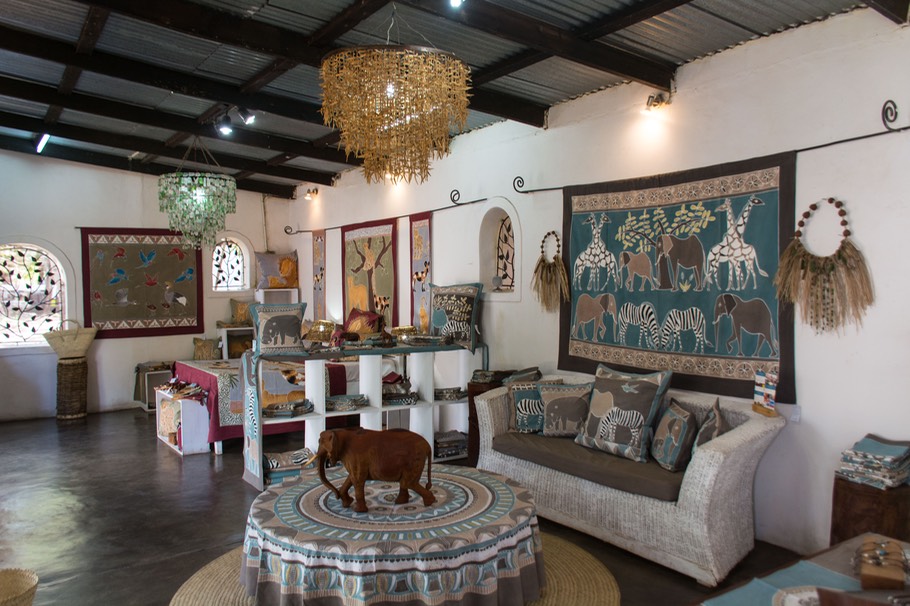
Oh yes, and one extra treat. Not far from the entrance to our camp was a village; and in that village was the marvelous Tribal Textiles showroom and work area. We had a great tour showing us how the fabrics are prepared and painted, and the whole rest of the process. They do lovely work there, that’s for sure. We found a pillow cover to go with the one we’d bought in Lusaka earlier in the year, and we are very pleased with them. We really liked a sign on the wall at this spot, “There is no Planet B”. Can’t really argue with that can you?
Eventually, we moved on, delighted to have visited. We drove back through Chipata and then turned to the west, heading for Lusaka. We talked about the shades of difference between Zambia and Malawi. As we have said before, nothing beats Malawi in terms of peaceful, gentle people; and the women’s clothing is the best/prettiest we’ve seen. The wrap skirts they universally wear, called chitenge, are incomparable. In Zambia the clothing starts being less dramatic, and is seen less frequently. On the other hand, here in southeastern Zambia we are seeing more dramatic scenery, and definitely there are more animals to be enjoyed. Maybe the roads are a bit better, at least along this stretch, and you can’t beat a road sign like the following —
“OUGH ORK AHEA”
Africa does continue to delight us!
We noticed the hills we were driving through were very dry, and that the river we’d just been staying at seemed quite low; all confirming what we’d been told in June, that southern Zambia got almost no rain this year. We crossed a very high bridge over the junction of the Luangwa and Lunsemfwa rivers; not much water now, but that bridge is very high for a reason!
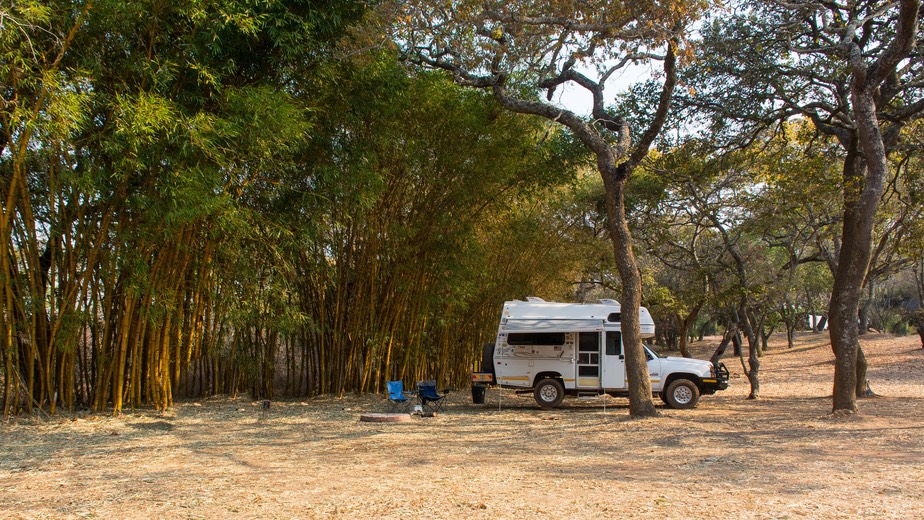
After crossing these rivers we started climbing back into the mountains; we climbed up and down, crossing several low ridges. Lots of trucks were stuck, sitting beside the road while they called for help or made repairs. Some were unloading cargo and putting it on other trucks. Such a mess for them. Stuck for hours? days? weeks?
We arrived at a camping lodge a bit east of Lusaka, a place called Pioneer Camp; it was a very nice spot where we stayed for a few days. Coming in, we met up with Bev and Peter, our new friends from the South Luangwa NP area. It was very nice to see them again.
We also met some bicyclists from America. These guys were quite something! One fellow was from Arizona and the other from New Jersey. Apart from traveling on bikes, which always amazes and impresses us, they had both been traveling for a long time, but had met each other while on the road — in China no less. The most surprising thing about them was that while the older fellow had started his travels on a bicycle, when they met the younger man had been traveling in other ways. After leaving China, they ditched the bikes and traveled together by motorbikes in southeast Asia, for which the younger guy had to take a motorcycle riding training class! Amazing. Anyway, we had a nice visit; other travelers are often so interesting!
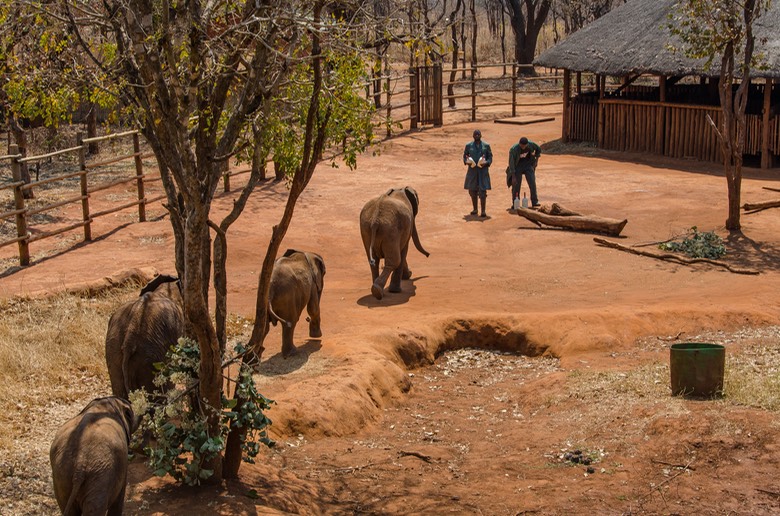
We moved on into Lusaka, returning to familiar territory, and did some shopping we’d been wanting to do. Malls can be hard for us due to their use of height barriers, but the one in Lusaka called Manda Hill is very friendly, even having a parking area set aside for overland trucks. There are stores here we’d not seen in quite awhile so stocking up was a pleasure.
After we’d spent our wad and filled our minuscule larder, we settled in for the night back at the Backpackers campsite in the middle of town. We like being here; the guys who run it are old friends by now, and we were welcomed with grins and open arms. Backpacker hostels are always good stopping places; we meet people who travel the same way we do, and can chat about where we’re heading next and get good advice on how to make it all work for us. We got lots of feedback on where to go and stay while checking out the Lower Zambezi NP.
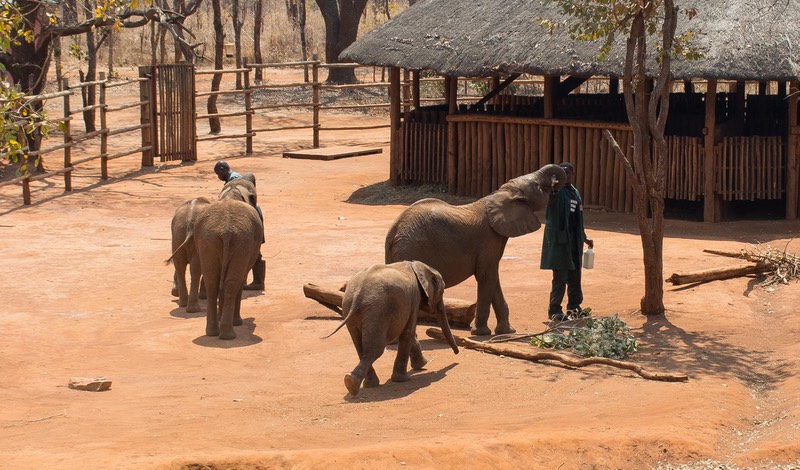
Another place we wanted to get a chance to visit was the chimpanzee rescue center at Chimfunshi in far northern Zambia. We’d been heading there back in June when we had to stop because we were not feeling well and didn’t want to expose the chimps to whatever we had. So we checked their website and sent off an email inquiring about the particulars of the walk with the chimps others had spoken of so highly. We received a very nice reply. They’d love to have us come and see the chimps but they were no longer offering the walks in the forest. Well, as this had been the biggest, most important reason to make the drive — a chance to interact with the chimps — the 1,000 km round trip up there and back just didn’t make sense, and we decided to not go.
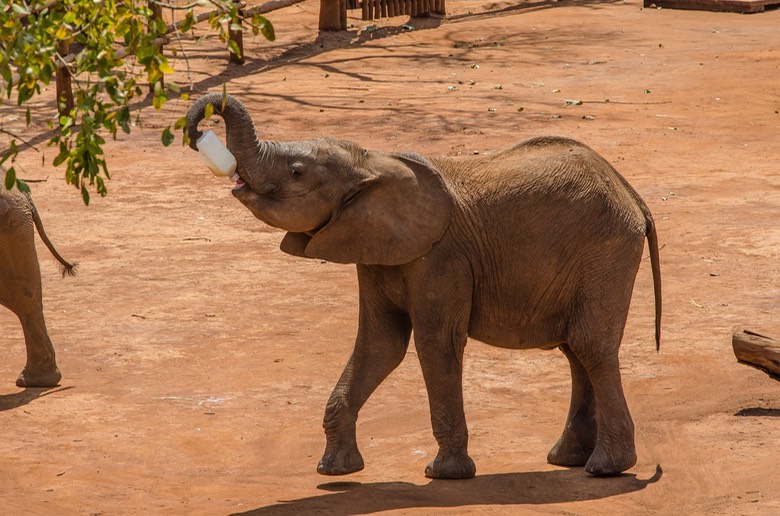
For now, our next destination was the area called the Lower Zambezi River, with its access to the famous river after it goes over Victoria Falls. But before being ready to move on out of town, we had one last stop we were interested in. We’d been told about a place called the Lilayi Elephant Orphanage, on the edge of metropolitan Lusaka, where there is a baby elephant rescue site that’s pretty interesting. So we stopped there, late in the morning, the right time for feeding the babies. There were four of them, all very cute, slurping down their bottle of liquid nourishment in about 10 seconds (they get fed every 3 hours).
We’ve seen plenty of baby elephants in the wild, but had not seen them take a two-liter plastic jug of formula up with their trunks and chug-a-lug it down; that was fun. We learned about how long they stay there, where they go next, and… of course… how we could help support the operation. It was a nice treat, if maybe a bit too commercial for our taste. One thing we learned was the word, “Ubuntu”, meaning “I am because you are”. We thought that was pretty nice. If you’re heading that way, you might want to stop by.
Saying good-by to the elephants, we beat feet outta the city area. Whew! Once back on the road, we made our way through the-speed-trap-known-as-Kafue (which had gotten its pound of flesh out of us earlier this year), then turned off the T2 onto the road to Chirundu. We said “Phooey Kafue” and headed towards the Lower Zambezi National Park area.
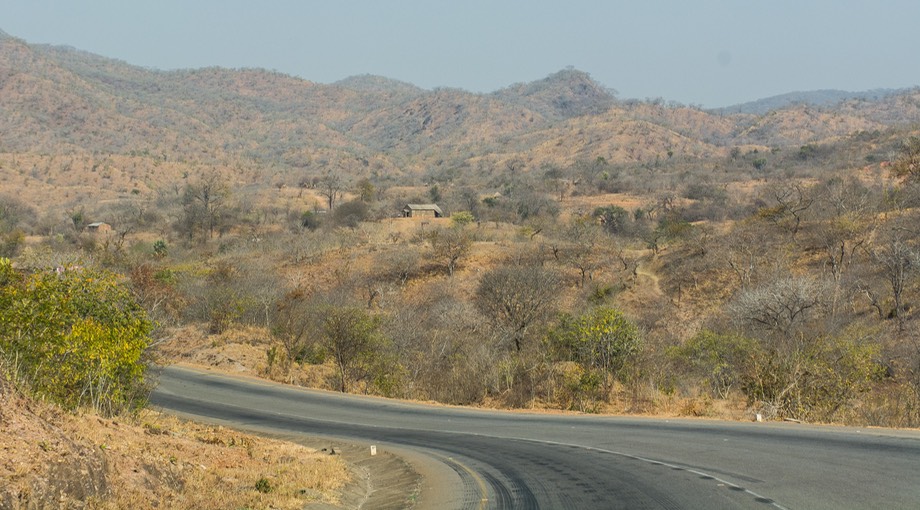
At Chirundu we turned sort of northeast a bit, and left the highway to drive along the Zambezi River. Along this pathway, the river forms the borderline between Zambia and Zimbabwe, which we thought was great. The deal here is that you can’t camp in the national park. You stay at one of the many lodges along the river road that heads that way and they have safari wagons and take you in on drives if you like; or you can also self-drive in your own vehicle. We were interested in staying close to the park itself, and hopefully arranging a boat trip to see some game and enjoy the park from the water. We were delighted to see that the words Mvuu and Kubu were being used here regularly in the names of lodges; both mean “hippo”, in various local dialects. A bit of whimsy for you.
With some recommended lodging destinations in mind, in growing heat, we made our way down the dirt road that led toward the park. We looked at one really nice place, and would have stayed despite the exorbitant cost being asked (about three times what we were accustomed to). But they couldn’t let us get parked up right then. “Sorry, I can’t take you to your campsite at the moment — there are elephants wandering in there right now.” Well, cool! We could look over and see the group of four that was eating the yummy leaves off the trees nearby. We’d have lunch; they promised it wouldn’t be long.
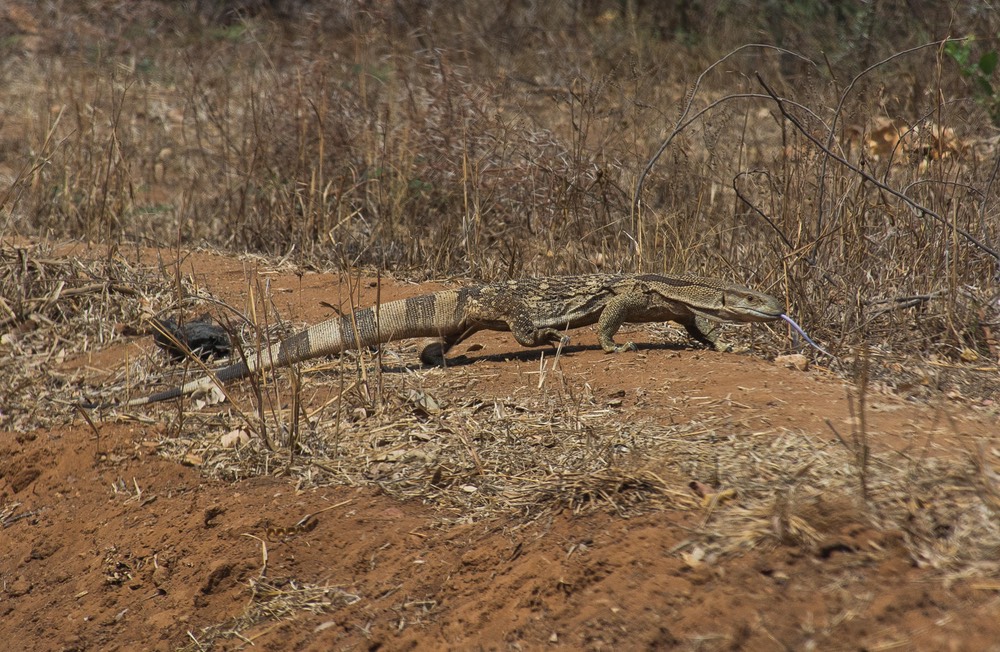
Eventually, it got hotter and hotter and the beasties weren’t going anywhere. After lunch, we got info on what kinds of activities were offered. Yes, we could have a boat ride in the nearby area… but was that really the price? Wow. Etc. Finally, they lost us. We had far too much time to think about how much all this was going to cost, even if it did include elephants in our back yard. Not being able to settle for the day and enjoy our own campsite made it easier to just move on.
We said thanks but no thanks and wandered on to where we checked out another recommended site, but they were jammed full with a big group about to arrive. A very busy area! We regrouped, realizing all we really wanted was a reasonable spot to sit by the water for a couple of days and hopefully take a boat ride.
These last two spots were the two closest to the NP, so we had to turn back the way we came, and that worked better. We found a place at a good price with a nice open area, lovely breezes coming up the river, and a shady place to sit and enjoy the hippos nearby as well as the elephants and hippos across the river on the Zimbabwe side. It never quite worked out that we got our ride out on the waters of the Zambezi River, but that’s okay. We enjoyed ourselves at this nice little casual spot, the people were lovely to us and quite caring, and one night we heard lions roaring from across the river; they are really loud.
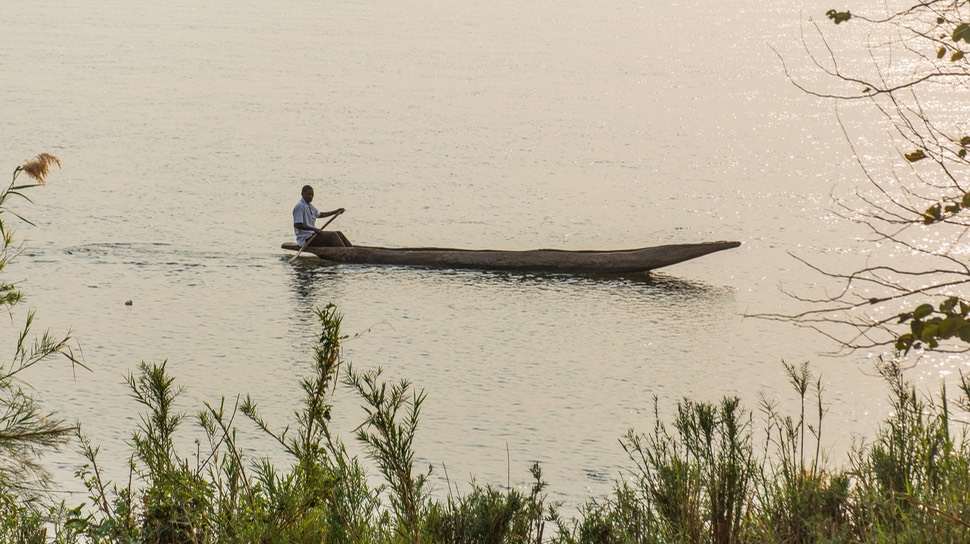
This is a nice enough area, and the river is splendid. But it’s a huge tourist attraction without the proper infrastructure. There are large safari trucks constantly going between Chirundu and the Park entrance, and they drive fast. It’s a dirt road all the way in, and you travel through several villages. We could see how this was affecting the people who lived there. The dust was very bad, for one thing. But worse, the children had taken up begging, which we’d not seen in very many places in Zambia (and almost never in Malawi). The people scowled at us as we drove past, which is something we only see in heavily touristed areas. This, plus the proximity to a large border town, makes the area not what you might want it to be. We felt sorry for them. Also, the heavy tourist presence is what raises the costs. We were missing Malawi.
After a couple of days we decided to move on, heading toward Livingstone, a great decision-making town, as it’s a real crossroads area. And we were ready to decide what was next.
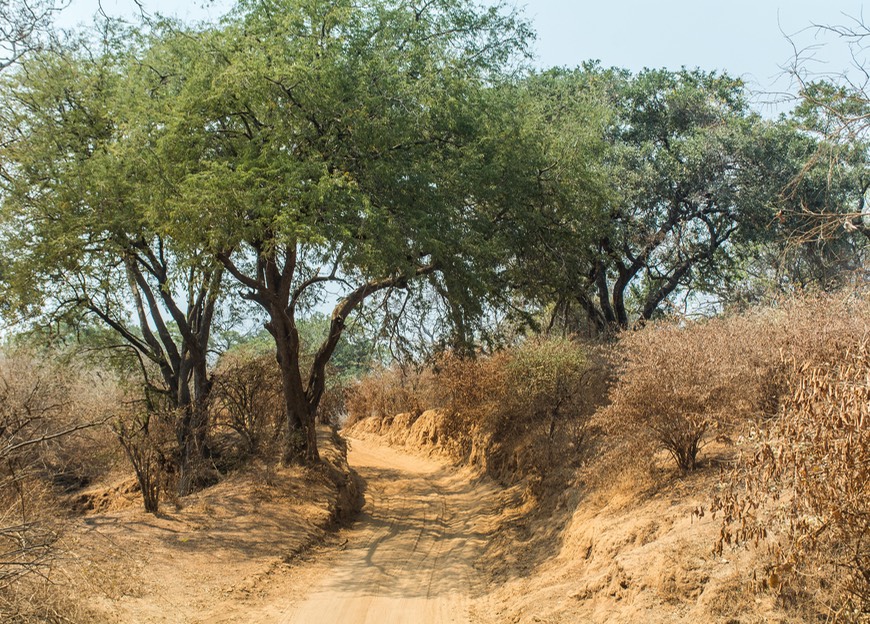
We took a back road to rejoin the highway south of Lusaka. It was a lonely, dry desert road; we thought it was the right one although the signage was not good and the GPS didn’t even know the road existed. But Petra and Win had said it was a good road and had marked it on our map. And they were right on. Some of the confusion was because the name of one of the key towns had been changed (no longer Fumbo — now Munyumbwe), but the road was in pretty good shape. It was mostly paved except between Munyumbwe and Gwembe, and it delivered us to the highway as promised. Driving along, we were reminded of the dry countryside of Kaokoland in northwestern Namibia — rural/primitive houses with kraals made from tree limbs; bare dirt and very desolate. It would be more attractive after the rainy season.
When we emerged back on the highway we turned south toward Livingstone and on arriving we felt that the town was quite busy, with more people around than had been there in June. We did some shopping (yes, again) and checked on the news. In Lusaka there had been looting of the stores at some of the malls, including at Manda Hill Shopping Center, where we had enjoyed making purchases a few days earlier. We also heard there were disturbances in Nigeria, and in South Africa. Lusaka was relatively calm, but these other areas had experienced real violence.
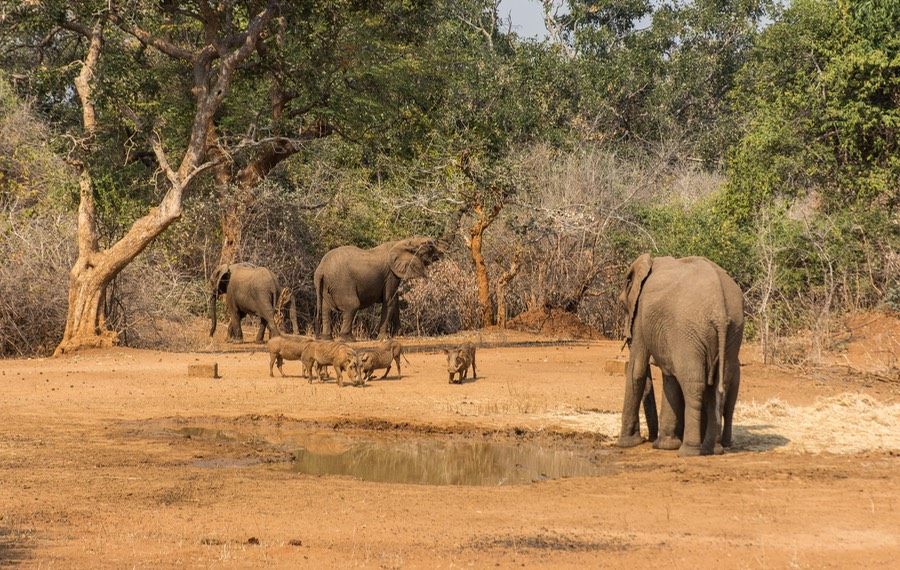
We went on out to Thorn Tree House, south of town, where we’d stayed before. The owner is a woman with a real pulse on what’s going on in the area and we wanted to talk to her. She was in Lusaka but would be back late that night and would come find us in the morning. We met up the next day and enjoyed a nice chat.
Claire had been at the Manda Hill mall when the looters arrived, having a cup of coffee in one of the cafes. Interestingly, she said they weren’t violent at all, and nobody was injured; and we talked about what was going on. These recent difficulties had nothing to do with the problems in Zimbabwe, but were resulting from anti-immigrant violence in South Africa, mostly in the Jo’burg area. Local blacks there are protesting what they see as too much immigration from other countries (Nigeria in particular) which is adding to unemployment and low wages for South African residents. All unfortunate of course, and adding to travelers’ concerns in making choices. Looting and demonstrations in Zambia and Nigeria were apparently directed at South African businesses and some chains were closing their stores.
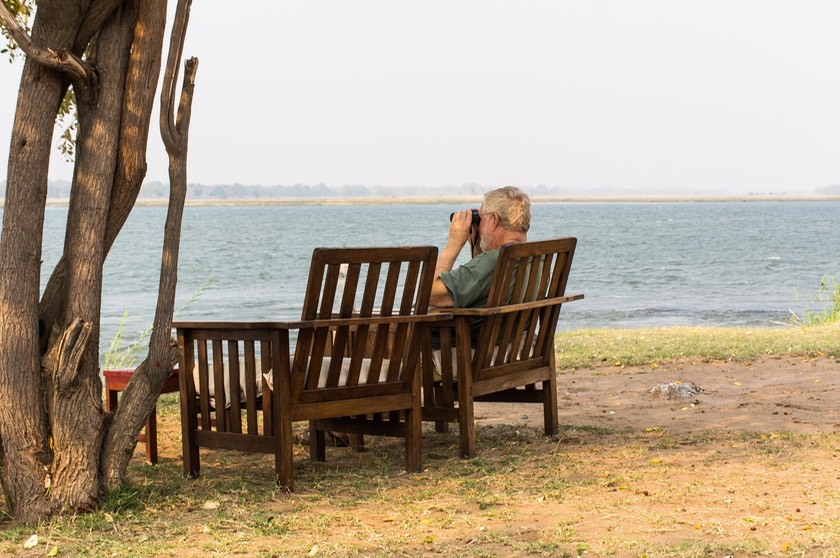
We had one last plan for Livingstone, and that was to check out the town’s well known museum. It was a interesting spot, although we couldn’t take any photos inside. The main theme seemed to be that rural/traditional Zambia was doing just fine, thank you, and when more modern ideas and approaches intruded, the residents didn’t always come out ahead. There were discussions about trash, about the lack of ability to continue some old but excellent traditions, etc. Very thought-provoking. There was also a good collection of animals and birds. Outside the building was a nice statue to David Livingstone.
We left Livingstone and headed further west, toward both Botswana and Namibia knowing that either would make a good next destination for us. Not far west of Livingstone we would be reaching the confluence of the Zambia, Botswana and Namibia borders — and by then we’d have to decide which way to turn. First, though, we sat beside the Zambezi River for our last night in Zambia, enjoying a lovely view, plenty of breeze, and a nice quiet evening.
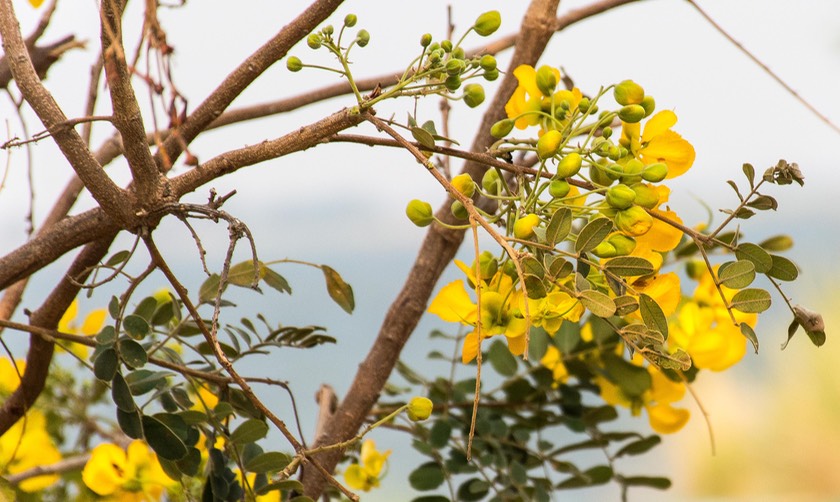
We remarked that we’d now slept alongside both the upper and lower Zambezi; we’d had a chance to watch the inner workings of a baboon family; had made new friends in several locations and spent more time with old friends; and were about to take a little ferry across a river — something we always enjoy. All of these are the “silver linings” to go with the “clouds” that had mucked about with our hoped for trip to Zimbabwe.
So now it was crossroads time. You’ll need to pay attention here; get out your best Africa map, ‘cause this area is full of choices. Here’s the deal. The road from Livingstone goes straight west, and takes you to Namibia. Or, you can turn off this road a ways along, and drive instead a bit south to Kazungula. There you reach the Chobe River, where you catch the ferry across the river into Botswana and to its border town of Kasane. To make things even more complicated, you can still go on to Namibia from here, by driving across the northern edge of Botswana and into Namibia that way. Or, from Kasane, you can turn south, travel along the eastern edge of Botswana, and on into South Africa to continue your adventures.
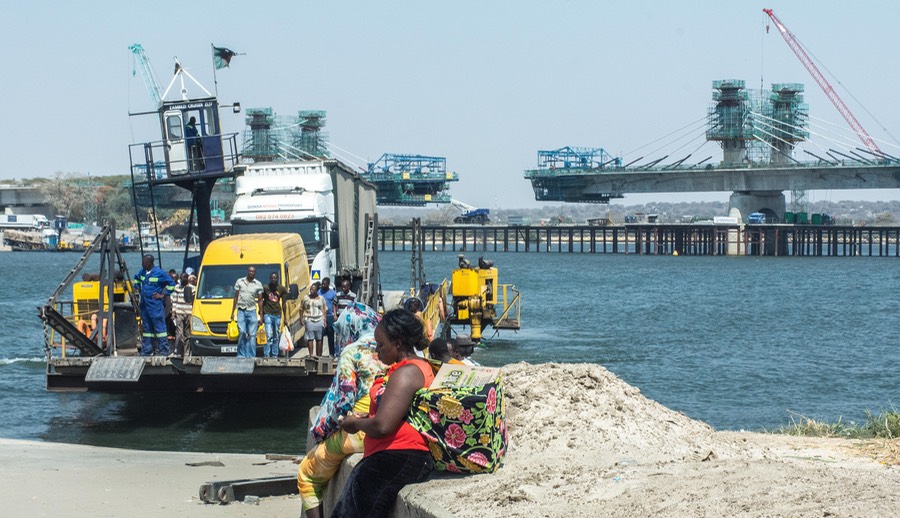
Got all that? Lost your map already? Well, take it from us; these are all good choices with really fun things to do and see wherever you exit the maze. What can we say but… WHEW! An embarrassment of riches; too many good options to choose among. And like any good crossroads, it’s all like one huge roundabout. If you can’t make up your mind which way you want to turn, and where you want to exit, you can just keep going round and round until you get it figured out. This is more or less what we did.
We knew we couldn’t make a wrong decision, choosing between more time in the Caprivi Strip and on to the cool Namibian coast, or heading back into South Africa to enjoy the excellent wild game viewing in the parks there. In the end, we decided to travel down eastern Botswana, an area reputed to have plenty of open countryside with free-roaming critters. Right? Wrong? Who knows, but we were happy with our decision to continue on our way south.
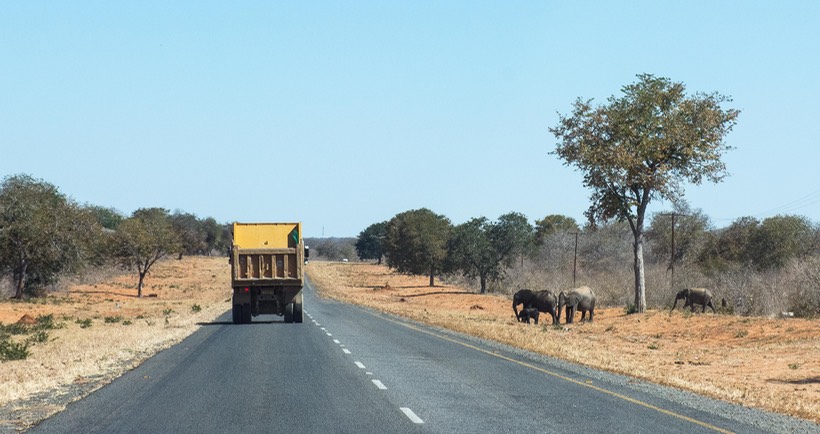
So we pointed Tiger south out of Kasane. We were quite happy to get out of there, actually. Kasane is a town in a bit of turmoil. We’ve mentioned the ferry across the river? Well, that’s a bit of a mess; there are only two of them these days, one originating in Botswana, the other in Namibia. Depending on which one you take, you pay in their local currency in order to get the better price. There are touts everywhere, trying oh, so hard to help you out with this (hah!), and to relieve you of more and more by guiding you through the border process. All the usual. In the midst of all this, a bridge is finally being built over the river (the Chobe, remember?) with all the chaos that entails; in between is no-man’s land filled with trucks. Such a mess.
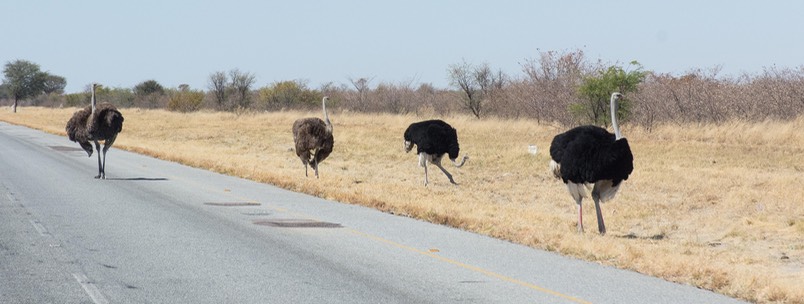
But then, the bliss of the open road. The corridor we traveled south on is a treat. We saw animals everywhere — giraffe, kudu, ostrich, elephants, zebra, vultures, baboons, impala, not to be outdone by bands of warthogs. We spent much of two days just slowly moving along and having a good time, stopping to watch our favorites as they munched their way through the day. We spent one night in the wild, near a lay bye (local spelling) warning that if you stopped there it was at your peril. We weren’t disturbed all night long; maybe there were some killer frogs that we just missed out on.
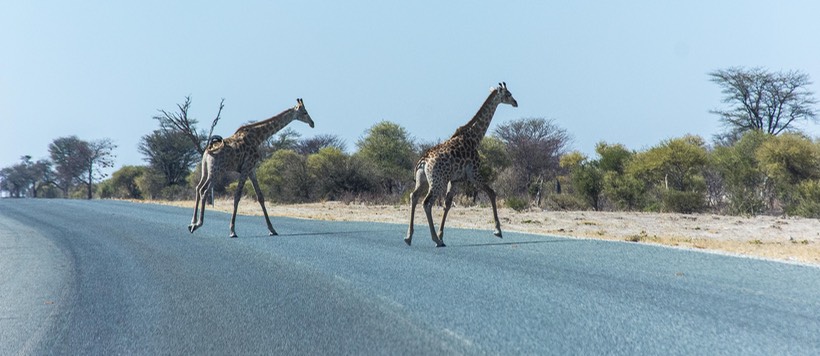
Eventually we got down to civilization again, Francistown to be exact, and then ultimately to Martin’s Drift, yet another chaotic border, where we crossed back into South Africa, roughly four months after leaving early in May. Having achieved the gold standard of SA visas — 90 days — we sighed contentedly and announced our intention to stay here until they kicked us out.
You might say that’s one of the best silver linings of all.
See y’all soon, one side or the other. R, K & LaT
Go see some more pictures of Zambia and Botswana on the Photo Page for this story